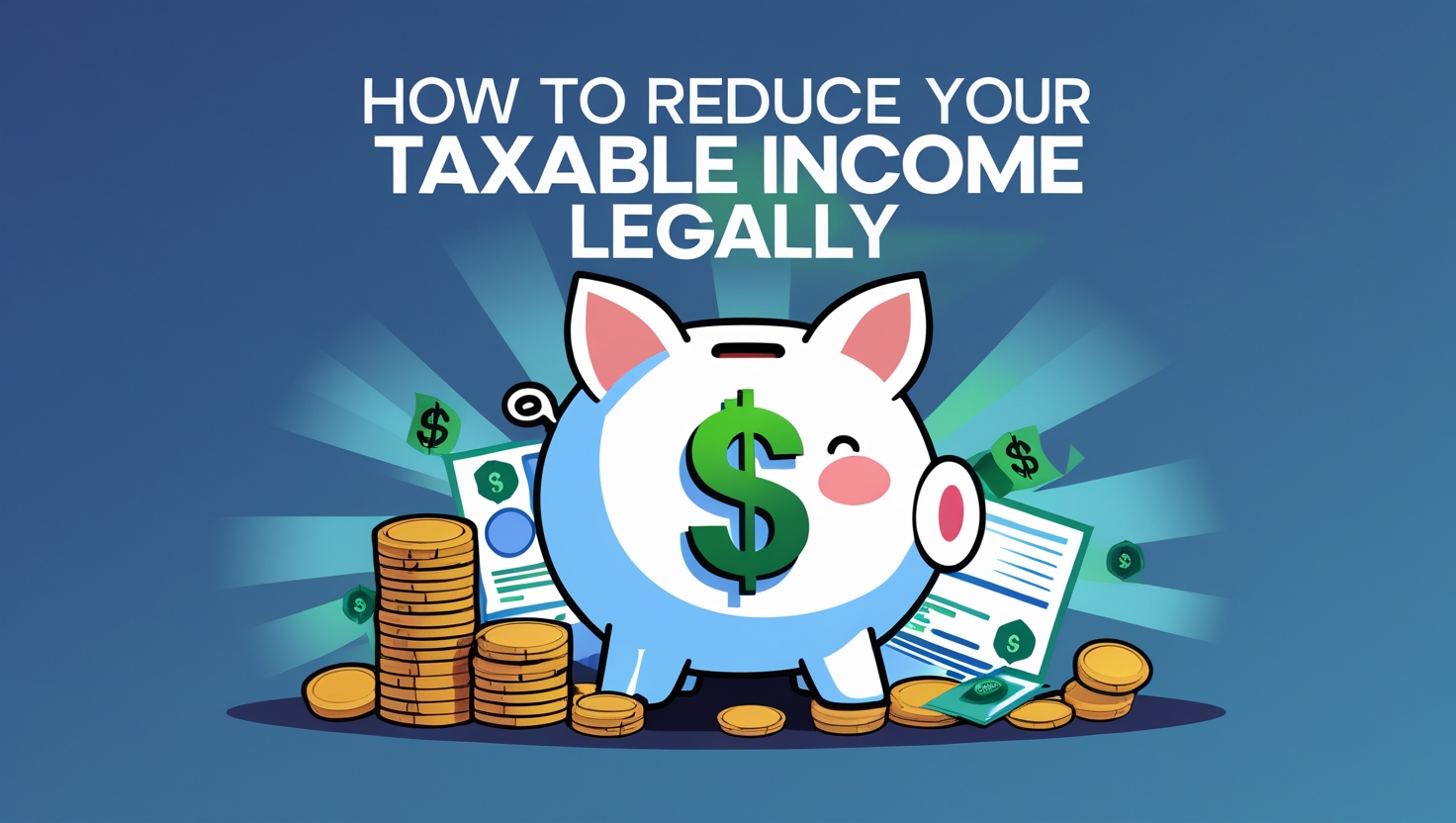Taxes. Just the word alone can make some people cringe. It’s no secret that taxes take a big chunk out of our hard-earned money, but what if I told you there are ways to legally reduce your taxable income? Yes, you heard that right. The U.S. tax system is complicated, but it also offers plenty of opportunities to lower what you owe Uncle Sam. And no, I’m not talking about shady loopholes or risky schemes. I’m talking about smart, legal strategies that anyone can use. Whether you’re a working professional, a small business owner, or just someone trying to make the most of your income, this guide will walk you through some of the best ways to keep more money in your pocket.
Before we dive in, let’s get one thing straight: reducing your taxable income isn’t about cheating the system. It’s about understanding the rules and using them to your advantage. The IRS allows certain deductions, credits, and strategies that can lower your tax bill, and it’s completely legal to take advantage of them. So, let’s get started!
1. Contribute to Retirement Accounts
One of the easiest and most effective ways to reduce your taxable income is by contributing to retirement accounts. Not only are you saving for your future, but you’re also lowering your tax bill in the present. Here’s how it works:
- 401(k) Plans: If your employer offers a 401(k) plan, you can contribute pre-tax dollars directly from your paycheck. For 2023, the contribution limit is 22,500 or 30,000 if you’re 50 or older. The money you contribute reduces your taxable income, so the more you save, the less you owe in taxes.
- Traditional IRAs: Similar to a 401(k), contributions to a traditional IRA are tax-deductible, depending on your income and whether you or your spouse are covered by a retirement plan at work. The contribution limit for 2023 is 6,500 or 7,500 if you’re 50 or older.
- Health Savings Accounts (HSAs): If you have a high-deductible health plan, you can contribute to an HSA. Contributions are tax-deductible, and withdrawals are tax-free when used for qualified medical expenses. For 2023, the contribution limit is 3,850 for individuals and 7,750 for families.
The best part? The money in these accounts grows tax-free until you retire. It’s a win-win!
2. Take Advantage of Tax Credits
Tax credits are even better than deductions because they reduce your tax bill dollar-for-dollar. Here are a few credits you might qualify for:
- Earned Income Tax Credit (EITC): This credit is designed to help low- to moderate-income workers. Depending on your income and family size, you could get a credit worth up to $7,430 in 2023. Even if you don’t owe taxes, you might still qualify for a refund.
- Child Tax Credit: If you have kids, you could be eligible for the Child Tax Credit, which is worth up to $2,000 per child under 17. There’s also an Additional Child Tax Credit, which can give you a refund even if you don’t owe taxes.
- American Opportunity Tax Credit (AOTC): If you’re paying for college, the AOTC can help. It’s worth up to $2,500 per student for the first four years of college. The credit covers tuition, fees, and course materials.
- Saver’s Credit: If you’re contributing to a retirement account and your income is below a certain threshold, you might qualify for the Saver’s Credit. It’s worth upto 1,000 for individuals or 2,000 for couples.
Tax credits can make a huge difference, so don’t overlook them!
3. Maximize Your Deductions
Deductions reduce your taxable income, which in turn lowers your tax bill. Here are some common deductions to consider:
- Standard Deduction vs. Itemized Deductions: For 2023, the standard deduction is 13,850 for single filers, 27,700 for married couples filing jointly, and $20,800 for heads of household. If your itemized deductions (like mortgage interest, medical expenses, and charitable contributions) add up to more than the standard deduction, you should itemize. Otherwise, take the standard deduction.
- Student Loan Interest: If you’re paying off student loans, you can deduct up to $2,500 in interest. This deduction is available even if you don’t itemize.
- Medical Expenses: If your medical expenses exceed 7.5% of your adjusted gross income (AGI), you can deduct the amount that goes over that threshold. This includes things like doctor visits, prescriptions, and even travel for medical care.
- Charitable Contributions: If you donate to qualified charities, you can deduct those contributions. Keep in mind that you’ll need receipts for donations over $250.
4. Start a Side Hustle or Small Business
If you’ve ever thought about starting a side hustle or small business, now might be the time. Why? Because business expenses are deductible. Here’s how it works:
- Home Office Deduction: If you use part of your home exclusively for business, you can deduct expenses like rent, utilities, and internet. The IRS offers a simplified option that lets you deduct $5 per square foot, up to 300 square feet.
- Business Expenses: Things like office supplies, travel, and even your phone bill can be deducted if they’re used for business purposes. Just make sure to keep detailed records.
- Self-Employment Tax Deduction: If you’re self-employed, you can deduct half of your self-employment tax. This can add up to significant savings.
Starting a side hustle isn’t just a way to make extra money—it’s also a smart tax strategy.
5. Use Flexible Spending Accounts (FSAs)
If your employer offers a Flexible Spending Account (FSA), take advantage of it. FSAs let you set aside pre-tax dollars for qualified expenses like medical costs or dependent care. The money you contribute isn’t subject to federal income tax, Social Security tax, or Medicare tax. For 2023, the contribution limit is 3,050 for health FSAs and 5,000 for dependent care FSAs.
The catch? FSAs are “use it or lose it,” so make sure you don’t contribute more than you’ll actually spend.
6. Harvest Investment Losses
If you have investments that have lost value, you can sell them to offset capital gains. This strategy is called tax-loss harvesting. Here’s how it works:
- Let’s say you sold some stocks and made a 5,000 profit. If you also sold other stocks at a 3,000 loss, you’d only pay taxes on $2,000 of capital gains.
- If your losses exceed your gains, you can use up to $3,000 of the excess to offset ordinary income. Any remaining losses can be carried forward to future years.
Tax-loss harvesting is a great way to minimize your tax bill while rebalancing your portfolio.
7. Defer Income
If you expect to be in a lower tax bracket next year, consider deferring income. For example:
- If you’re due for a bonus, ask your employer to pay it in January instead of December.
- If you’re self-employed, delay sending invoices until the end of the year so you don’t receive payment until the following year.
Deferring income can help you stay in a lower tax bracket and reduce your overall tax liability.
8. Give to Charity
Charitable giving isn’t just good for the soul—it’s also good for your taxes. If you itemize deductions, you can deduct donations to qualified charities. Here are a few tips:
- Donate appreciated assets like stocks or mutual funds. You’ll avoid paying capital gains tax, and you can deduct the full market value.
- If you’re 70½ or older, you can make a qualified charitable distribution (QCD) from your IRA. The money goes directly to charity and counts toward your required minimum distribution (RMD), but it isn’t included in your taxable income.
9. Take Advantage of Education Benefits
If you’re paying for education, there are several tax benefits you might qualify for:
- Lifetime Learning Credit: This credit is worth up to $2,000 per tax return for qualified education expenses. Unlike the AOTC, there’s no limit on the number of years you can claim it.
- Tuition and Fees Deduction: While this deduction expired in 2020, it’s worth keeping an eye on in case it’s reinstated. It allowed you to deduct up to $4,000 in tuition and fees.
- Student Loan Interest Deduction: As mentioned earlier, you can deduct up to $2,500 in student loan interest.
10. Hire a Tax Professional
Finally, consider hiring a tax professional. While it might seem like an added expense, a good accountant or tax preparer can save you far more than they cost. They’ll help you identify deductions and credits you might have missed, and they’ll ensure your return is accurate and filed on time.
Final Thoughts
Reducing your taxable income doesn’t have to be complicated. By taking advantage of retirement accounts, tax credits, deductions, and other strategies, you can keep more of your money and still stay on the right side of the law. Remember, the key is to plan ahead and stay organized. Keep good records, consult a professional if needed, and don’t be afraid to ask questions.
Taxes might be inevitable, but with a little effort and know-how, you can make them a little less painful. So go ahead—take control of your finances and start saving today. Your future self will thank you!











Leave a Reply